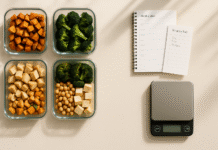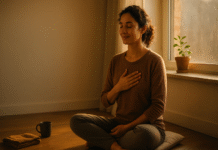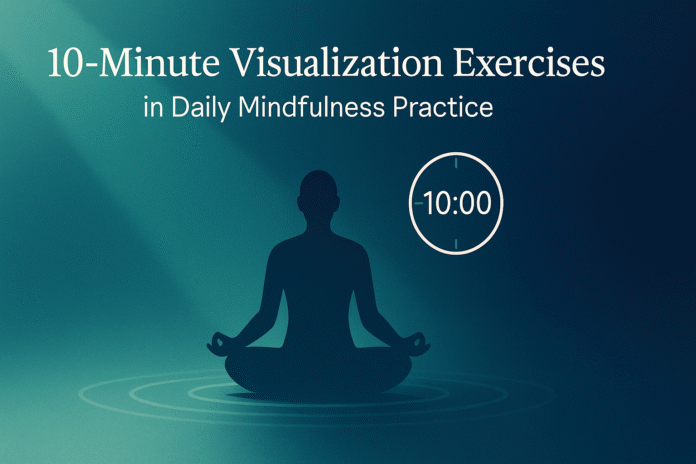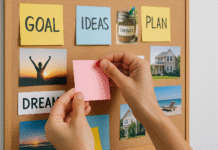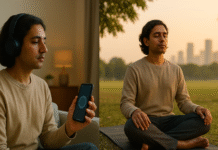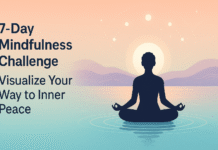If you can set aside ten minutes, you can change the feel of your day. Short, structured visualization—imagination put to work—slots neatly into daily mindfulness practice and helps you focus, regulate emotions, and reset your nervous system without needing a retreat or an hour-long session. In this guide, you’ll learn how 10-minute visualization exercises work, exactly how to do them, how to track results, and how to build a four-week plan you can actually stick with.
Disclaimer: The practices below are educational and not a substitute for medical or mental health care. If you have a history of trauma, panic, or other clinical concerns, consult a qualified professional for personalized guidance.
Key takeaways
- Ten minutes is enough to improve state mindfulness and attention for many people and fits into busy schedules.
- Visualization amplifies mindfulness by engaging sensory detail, focused attention, and a non-judgmental stance.
- Simple structure wins: clear cues, a timer, and a repeatable script remove friction and reduce mind-wandering.
- Measure what matters: mood, focus, and practice minutes are practical metrics; wearables can add heart-rate or HRV.
- Progress over perfection: start easy, avoid common pitfalls (e.g., forcing images), and scale up only when stable.
Why 10-Minute Visualization Works (and How It Supports Mindfulness)
What it is and core benefits
Visualization in mindfulness is deliberate, sensory-rich mental imagery paired with present-moment awareness and acceptance. You use an imagined anchor—like a calm place or a beam of light—to steady attention, soften reactivity, and guide the nervous system toward balance. This is not daydreaming; it’s structured, repeatable practice that you can deliver via audio, script, or memory.
Why ten minutes? Short sessions are easier to keep daily, reduce dropout, and—crucially—still produce meaningful effects on attention, state mindfulness, and stress regulation for many people. Short doses also integrate well with micro-habits (after coffee, before email, between meetings).
What changes with practice:
- More on-task attention and less mind-wandering.
- Quicker down-shifts from stress to steadiness.
- Better access to pro-social states (kindness, patience).
- Easier behavior follow-through when paired with brief planning imagery.
Requirements/prerequisites
- A timer (phone on Do Not Disturb), a comfortable seat, optional headphones.
- A script or recording; paper index cards work if you prefer analog.
- Optional: breath pacer app or watch to keep a slow, comfortable rhythm.
Low-cost alternatives: Use your phone’s built-in timer and a free voice memo you record yourself.
Beginner-friendly setup (2 minutes)
- Posture: Sit upright, supported, feet on floor; or lie down if you’re fatigued.
- Breath warm-up: Inhale through the nose, exhale through the mouth; gentle, not forced (about 4–6 breaths).
- Intent: Pick one outcome (e.g., “arrive calm for the 10 a.m. meeting”).
Safety, caveats, and mistakes to avoid
- Don’t force imagery. If you “see” nothing, switch to nonvisual senses (feel, sound, temperature) or use simple shapes/colors.
- Aphantasia (difficulty forming mental images) is okay—treat the script as a narrative and lean on breath/feeling cues.
- If a scene evokes discomfort, pivot to a neutral anchor (a dot of light, a single color, counting breaths).
- Avoid holding the breath or hyperventilating; keep breathing natural and comfortable.
Recommended frequency/duration/metrics
- Frequency: Daily if possible; otherwise 4–5 days/week.
- Duration: 10 minutes per session (extend later if helpful).
- Metrics: 1–10 mood and focus check-ins pre/post; weekly minutes practiced; optional resting heart rate/HRV from a wearable.
Mini-plan example (2–3 steps):
- Set a 10-minute timer. 2) Do 8 minutes of your chosen script. 3) Spend the last 2 minutes breathing quietly and noting one word for how you feel.
Quick-Start Checklist & 60-Second Warm-Up
Checklist
- Quiet spot found and phone silenced.
- Timer set to 10:00 with a gentle chime.
- One chosen script (printed or in your notes app).
- Clear “when” anchor (e.g., after morning coffee).
60-Second Warm-Up
- 20s: Roll shoulders, soften jaw, unknit brow.
- 20s: Inhale for 4, exhale for 6, twice.
- 20s: Set intention (“Practice calmly and kindly”). Start timer.
Exercise 1: Calm Place Visualization (8–10 minutes)
What it is and benefits
You mentally “go” to a safe, calming environment—beach, forest, room—engaging sight, sound, touch, and smell. It down-regulates arousal and quickly cultivates present-moment ease.
Requirements
- A simple script describing the scene.
- Optional: background ambient sounds at low volume.
Low-cost alternative: Write three bullet points (what you see, hear, feel). That’s enough.
Step-by-step
- Arrival: Close eyes; notice contact points (seat, feet).
- Enter the scene: Picture a doorway or path into your calm place. Name one visual (color), one sound (breeze), one tactile (warmth).
- Anchor the breath: Let breath match the scene (e.g., waves rolling in).
- Expand senses: Add two details (smell of pine, cool shade).
- Sit and savor: Rest attention on one repeating element (e.g., wave crest) and return there when distracted.
- Exit gently: Thank the space; open eyes; note one word (e.g., “steady”).
Modifications and progressions
- If images won’t form: Focus on temperature (sun warmth), texture (sand), or sound (wind).
- Progression: Add a 30-second compassionate phrase for someone you care about before exiting.
Frequency/duration/metrics
- 5–7 days/week, 10 minutes.
- Track perceived stress (1–10) before and after.
Safety & common mistakes
- Avoid loading the scene with heavy personal memories if they destabilize you.
- Don’t chase “perfect” images; consistency beats clarity.
Sample mini-plan
- 1 minute: breath and body awareness. 2) 8 minutes: calm place script. 3) 1 minute: return and note one word.
Exercise 2: Light Scan (Body Scan + Visualization)
What it is and benefits
A body scan guided by a “beam of light” that travels from head to toe. It enhances interoceptive awareness and reduces muscle tension while keeping attention anchored.
Requirements
- A simple head-to-toe checklist (crown, face, neck/shoulders, chest, arms/hands, abdomen, hips, legs/feet).
- A chair or mat.
Step-by-step
- Set the light: Imagine a warm, neutral light above the head.
- Sweep slowly: Let the light travel down, pausing at each region. Feel warmth/softening.
- Breathe along: Inhale as the light arrives; exhale to soften that area.
- Name and notice: Quietly label sensations: “tingle,” “heavy,” “neutral.”
- Close: Let the light rest at the heart or navel; breathe three easy breaths.
Modifications and progressions
- If sensation is dull: Press attention gently into contact points (back on chair, feet on floor).
- Progression: Add a single phrase per region (“soften the brow,” “wide collarbones”).
Frequency/duration/metrics
- 3–7 days/week, 10 minutes.
- Metric: number of times you noticed and released micro-tension.
Safety & common mistakes
- Skip areas that feel painful; use “wide field” awareness instead.
- Avoid holding breath while concentrating.
Sample mini-plan
- 2 minutes: settle. 2) 7 minutes: light scan. 3) 1 minute: rest and note mood.
Exercise 3: Color Breathing (Regulate and Re-center)
What it is and benefits
You imagine inhaling a helpful color and exhaling a color that represents tension. It provides a concrete, visual way to lengthen exhale and shift state.
Requirements
- A comfortable seat; an idea of your two colors.
Step-by-step
- Pick colors: Choose a soothing inhale color (e.g., blue) and an exhale color for strain (e.g., gray).
- Inhale image: See or sense the inhale color filling the chest.
- Exhale release: See the exhale color leaving like a mist.
- Repeat: 4–6 breath cycles; then breathe normally within that color field.
- Finish: Let both colors fade; feel the natural breath.
Modifications and progressions
- If you can’t “see” colors: Imagine temperature (cool in, warm out), or texture (smooth in, coarse out).
- Progression: Match breathing to a 4-second inhale / 6-second exhale if comfortable.
Frequency/duration/metrics
- Use as needed, especially before meetings or sleep; 10 minutes or split into two 5-minute sets.
- Metric: pre/post heart rate if you track it; otherwise anxiety 1–10.
Safety & common mistakes
- Do not force long exhales; dizziness means return to normal breathing.
- Keep shoulders soft; avoid “breathing with the neck.”
Sample mini-plan
- 1 minute: settle. 2) 7 minutes: color breathing. 3) 2 minutes: quiet rest.
Exercise 4: Future-Self Rehearsal (WOOP-Style Visualization)
What it is and benefits
You mentally rehearse a near-future situation (presentation, workout, tough conversation). You imagine your Wish, the Outcome in sensory detail, the likely Obstacle, and a simple Plan to meet it. It builds clarity, motivation, and follow-through.
Requirements
- A pen or notes app; one scenario you care about.
Step-by-step
- Wish (1 minute): Name a realistic, meaningful outcome for today or this week.
- Outcome (2 minutes): Visualize success as vividly as possible: what you see, hear, and feel.
- Obstacle (2 minutes): Picture the most likely internal snag (e.g., “self-doubt at slide 3”).
- Plan (3 minutes): Form an if-then: “If self-doubt shows up, then I breathe once, soften shoulders, and read the slide title out loud in my head.”
- Wrap (2 minutes): See yourself carrying out the if-then smoothly, then open eyes.
Modifications and progressions
- If future imagery spikes anxiety: Shorten the scene and pair with Color Breathing first.
- Progression: Add a second obstacle/if-then after a week.
Frequency/duration/metrics
- Use before challenging events, 3–5 days/week.
- Metric: did you execute the plan? Y/N; add a confidence rating 1–10.
Safety & common mistakes
- Keep goals specific and near-term; vague dreams dilute attention.
- Don’t catastrophize the obstacle—one likely snag is enough.
Sample mini-plan
- Write “Wish/Outcome/Obstacle/Plan.” 2) Close eyes and rehearse. 3) Re-write the if-then on a sticky note.
Exercise 5: Compassionate Friend (Loving-Kindness Imagery)
What it is and benefits
You imagine someone you easily care about (or a pet) and silently offer short goodwill phrases. Visualization helps generate warmth; the phrases shift your social/emotional tone.
Requirements
- A short phrase set: “May you be safe. May you be healthy. May you be at ease.”
- A comfortable seat.
Step-by-step
- Bring to mind a person or being who evokes uncomplicated warmth.
- See them clearly: facial expression, posture, voice.
- Offer phrases, timed to the breath; imagine the words as light.
- Include yourself: briefly place your image in front of you and offer the same phrases.
- Widen outward to a neutral person if you like.
Modifications and progressions
- If people feel complex: Start with a pet or a place; you can also picture a simple warm light.
- Progression: Expand to include a difficult person for one gentle phrase after two weeks.
Frequency/duration/metrics
- 3–7 days/week, 10 minutes.
- Metric: after practice, rate warmth/irritability 1–10.
Safety & common mistakes
- Don’t force positive emotion; keep phrases soft and steady.
- If sadness arises, acknowledge it and shorten the circle.
Sample mini-plan
- 1 minute: settle. 2) 8 minutes: compassionate phrases with imagery. 3) 1 minute: sit quietly.
Exercise 6: Pebble-in-the-Pond Focus (Attention Training)
What it is and benefits
You visualize a single pebble dropping into still water and keep attention with the ripples as they expand and fade. It trains sustained, non-reactive focus.
Requirements
- Timer; optional: a small real pebble to hold briefly.
Step-by-step
- Picture the pond.
- Drop the pebble: watch ripples form and widen.
- Track one ripple: follow it to the edge; when it ends, start anew.
- Repeat for the session, noticing mind-wandering and returning without comment.
Modifications and progressions
- If ripples are hard to see: Imagine a circle of light expanding from the center.
- Progression: Increase the delay before dropping the next pebble by one breath.
Frequency/duration/metrics
- Daily, 10 minutes.
- Metric: count gentle “returns” from distraction; fewer over time suggests strengthening focus.
Safety & common mistakes
- Avoid gripping or “trying hard.” Replace pressure with curiosity.
- Don’t speed-drop pebbles; let the ripple complete.
Sample mini-plan
- 1 minute: breath. 2) 8 minutes: pebble visualization. 3) 1 minute: note returns.
Exercise 7: Doorway Reset (Micro-Visualization for Transitions)
What it is and benefits
Each time you pass through a literal doorway, you mentally step into a brief scene that matches your next context—a focused office, a warm living room, a clean gym floor. It installs state cues throughout the day.
Requirements
- A one-line cue saved on your phone lock screen: “Doorway = 3 breaths + next-scene image.”
Step-by-step
- Stop at the threshold.
- Three breaths with shoulders softening.
- See the next scene: one visual, one sound, one action you’ll take in the first minute. Then proceed.
Modifications and progressions
- If you forget often: Stick a colored dot on your doorframe.
- Progression: Add a micro-phrase (“I arrive ready; one thing at a time.”)
Frequency/duration/metrics
- Multiple times daily (5–30 seconds each), plus one 10-minute session as “anchor.”
- Metric: tally resets/day; track perceived smoothness of transitions 1–10.
Safety & common mistakes
- Don’t extend the pause when rushed; keep it truly micro.
- Avoid turning it into self-critique; the goal is reset, not perfection.
Sample mini-plan
- Choose a doorway you use often. 2) Set the lock-screen reminder. 3) Do the reset at least twice today.
Troubleshooting & Common Pitfalls
- “I can’t visualize.” Replace visuals with nonvisual anchors: temperature, pressure, sound, or simple geometric shapes.
- “My mind won’t stop.” Shorten scripts, add a tactile anchor (hand on chest), and count gentle returns without judgment.
- “I get sleepy.” Try upright posture, morning sessions, and cooler room temperature. Consider standing Color Breathing.
- “It feels fake.” Reduce adjectives; keep scenes plain. The point is steadiness, not cinematic detail.
- “No time.” Use Doorway Resets during the day and one 10-minute anchor at a consistent time.
- “I get overwhelmed.” Switch to neutral imagery (dot of light), shorten to 3–5 minutes, or pair with slow, comfortable breathing.
- “My chest gets tight.” Return to normal breathing; never force long inhales or exhales. If persistent, consult a clinician.
How to Measure Progress (Without Overthinking It)
Simple weekly scorecard
- Practice minutes: total per week.
- Mood/focus delta: average post-minus-pre rating (1–10).
- Attention returns: average number per session in Pebble exercise.
- Transitions smoothed: how often Doorway Resets helped (yes/no).
- Optional physiology: resting heart rate or HRV trend from a wearable (look for gentle improvement over weeks, not days).
What “good” looks like by week 4
- You practiced ≥4 days/week.
- Post-practice mood improved ≥1 point on average.
- Fewer “returns” needed during attention practice (trend, not perfection).
- You’re reaching for the practice without friction most days.
A Simple 4-Week Starter Plan (10 Minutes/Day)
Week 1 — Build the anchor
- Mon–Fri: 10 minutes daily: Calm Place or Color Breathing.
- Sat/Sun: Optional 10 minutes or two Doorway Resets.
- Focus: practice after a stable cue (after coffee, before email).
- Metric: mood 1–10 pre/post.
Week 2 — Add body and attention
- Mon/Wed/Fri: Light Scan (10 minutes).
- Tue/Thu: Pebble-in-the-Pond (10 minutes).
- Weekend: One Compassionate Friend session.
- Metric: track “returns” during Pebble practice.
Week 3 — Rehearse real life
- Mon/Thu: Future-Self Rehearsal (WOOP).
- Tue/Wed/Fri: Calm Place or Color Breathing.
- Daily: Doorway Resets at least twice.
- Metric: did you execute the if-then plan? Y/N.
Week 4 — Personalize and stabilize
- Choose your top two exercises; alternate them on weekdays.
- Add one progression: slightly longer exhale, or expand Compassion practice outward.
- Weekend: One longer 15-minute session if it feels natural.
- Metric: weekly reflection—what helped most; what to drop.
Safety Notes, Caveats, and Good Practice Hygiene
- If you have a history of trauma or panic, favor neutral anchors (shapes, light) and keep eyes open if that feels steadier.
- Stay within comfortable breathing; lightheadedness means you’ve pushed too far—return to normal breaths.
- Visualization is not a replacement for therapy or medical care; it’s a complement.
- Skip emotionally loaded scenes early on; pick them up later with support if desired.
- Consistency over intensity: ten calm minutes beat thirty strained ones.
FAQs
1) Do I need to “see” images clearly for this to work?
No. Many people “sense” rather than “see.” Use sound, temperature, texture, or simple shapes/colors. Benefits come from steady attention and non-judgment, not visual fidelity.
2) Is ten minutes really enough?
For many beginners and busy practitioners, ten minutes boosts state mindfulness and focus and can lower perceived stress. Some will later choose 15–20 minutes; start with ten and evaluate results after four weeks.
3) What time of day is best?
The “best” time is the one you’ll keep. Mornings often work well; a second session in late afternoon can reset before evening.
4) Can I do visualization while walking?
Yes—use Doorway Resets or Color Breathing with eyes open and attention on safe footing. Keep it simple; save richly layered scenes for seated practice.
5) What if I fall asleep?
Practice earlier in the day, sit upright, and try the Pebble exercise, which is more cognitively engaging. Shorten to 6–8 minutes temporarily.
6) Will this replace my breath meditation?
No need to replace. Visualization complements breath or open-monitoring practice. Many alternate days or sandwich 6 minutes of visualization between 2 minutes of quiet breath at start and finish.
7) How do I avoid ruminating during Future-Self Rehearsal?
Keep scenarios short and near-term (today/this week), include one likely obstacle, and pair it with a simple if-then plan. If anxiety rises, switch to Calm Place first.
8) I get frustrated when I notice mind-wandering. What now?
Counting a “return” is the rep. Label it gently (“thinking”), return to the anchor, and consider shorter scripts to reduce off-ramps.
9) Can kids do these exercises?
Yes—simplify language and shorten to 3–5 minutes. Color Breathing and Calm Place are kid-friendly.
10) Is music helpful?
Sometimes. Low-volume ambient sound can mask distractions, but lyrics compete with imagery. If music pulls attention, go silent.
11) Can I measure progress with a wearable?
If you enjoy data, track resting heart rate or HRV trends weekly. Treat numbers as gentle indicators, not grades.
12) What should I do after a tough session?
Close with three natural breaths, look around the room to orient, and do a brief stretch. You can always switch to a neutral anchor next time.
Conclusion
Ten minutes of visualization, practiced most days, is a powerful, sustainable way to steady attention, soften stress, and bring kindness into your daily rounds. Start small, keep scripts simple, measure what matters, and let consistency do the heavy lifting.
CTA: Pick one exercise above, set a 10-minute timer, and take your first mindful, imaginative breath today.
References
- 10 minutes of daily mindfulness may help change your outlook about health improvements, Harvard Health Publishing, December 1, 2024. https://www.health.harvard.edu/mind-and-mood/10-minutes-of-daily-mindfulness-may-help-change-your-outlook-about-health-improvements
- Brief Mindfulness Meditation Improves Attention in Novices: Evidence From ERPs and Moderation by Neuroticism, Frontiers in Human Neuroscience, 2018. https://www.frontiersin.org/articles/10.3389/fnhum.2018.00315/full
- Brief Mindfulness Meditation Training Reduces Mind-Wandering: The Critical Role of Acceptance, Emotion (NIH Public Access Author Manuscript), 2016. https://pmc.ncbi.nlm.nih.gov/articles/PMC5329004/
- The effect of ten versus twenty minutes of mindfulness meditation on state mindfulness and affect, Scientific Reports, November 24, 2023. https://pmc.ncbi.nlm.nih.gov/articles/PMC10673854/
- Systematic review and individual participant data meta-analysis of randomized controlled trials assessing mindfulness-based programs for mental health promotion, Nature Mental Health, July 10, 2023. https://www.nature.com/articles/s44220-023-00081-5
- Investigating the Impact of Guided Imagery on Stress, Brain Waves, and Attentional Control, Sensors, 2023. https://www.mdpi.com/1424-8220/23/13/6210
- Single Slow-Paced Breathing Session at Six Cycles per Minute: Investigation of Dose-Response Relationship on Cardiac Vagal Activity, International Journal of Environmental Research and Public Health, November 26, 2021. https://pmc.ncbi.nlm.nih.gov/articles/PMC8656666/
- Improvement of Interoceptive Processes after an 8-Week Body Scan Intervention, Frontiers in Human Neuroscience, 2017. https://www.frontiersin.org/journals/human-neuroscience/articles/10.3389/fnhum.2017.00452/full
- Loving-kindness meditation: a tool to improve healthcare provider compassion, resilience, and patient care, Journal of Compassionate Health Care, December 19, 2014. https://jcompassionatehc.biomedcentral.com/articles/10.1186/s40639-014-0004-7
- Imagining the way forward: A review of contemporary motor imagery theory, Frontiers in Human Neuroscience, December 22, 2022. https://pmc.ncbi.nlm.nih.gov/articles/PMC9815148/
- Effective Relaxation: Progressive Muscle Relaxation, Deep Breathing, and Guided Imagery in Promoting Psychological and Physiological States of Relaxation, Complementary Therapies in Clinical Practice, 2021. PubMed summary and PMC record: https://pubmed.ncbi.nlm.nih.gov/34306146/ and https://pmc.ncbi.nlm.nih.gov/articles/PMC8272667/
- Mindfulness meditation: A research-proven way to reduce stress, American Psychological Association, October 30, 2019. https://www.apa.org/topics/mindfulness/meditation
- Guided imagery for anxiety disorder: Therapeutic efficacy—A systematic review and meta-analysis, International Journal of Nursing Practice (NIH Public Access Author Manuscript), 2023. https://pmc.ncbi.nlm.nih.gov/articles/PMC10871407/
- Protocol for a prospective, randomized, controlled trial of Mental Contrasting with Implementation Intentions (MCII) to enhance the effectiveness of VA’s MOVE! weight management program: WOOP VA, Contemporary Clinical Trials (PubMed), June 2024. https://pubmed.ncbi.nlm.nih.gov/38608752/





